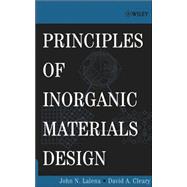
Note: Supplemental materials are not guaranteed with Rental or Used book purchases.
Purchase Benefits
Looking to rent a book? Rent Principles Of Inorganic Materials Design [ISBN: 9780471434184] for the semester, quarter, and short term or search our site for other textbooks by John N. Lalena (Gonzaga University in Spokane, WA); David A. Cleary (J.N. Lalena Consulting, in Puyallup, WA). Renting a textbook can save you up to 90% from the cost of buying.
DAVID A. CLEARY, PhD, is Professor of Chemistry and Chair of the Department of Chemistry at Gonzaga University. His courses have included physical chemistry and solid-state chemistry. His research interests range from nonlinear optical materials to chemical sensors and ionic conductors.
| Foreword | xi | ||||
| Preface | xv | ||||
|
1 | (44) | |||
|
2 | (17) | |||
|
19 | (14) | |||
|
33 | (6) | |||
|
39 | (6) | |||
|
45 | (72) | |||
|
45 | (8) | |||
|
53 | (5) | |||
|
58 | (14) | |||
|
72 | (26) | |||
|
98 | (10) | |||
|
108 | (9) | |||
|
117 | (24) | |||
|
117 | (3) | |||
|
120 | (3) | |||
|
123 | (4) | |||
|
127 | (6) | |||
|
133 | (4) | |||
|
137 | (1) | |||
|
138 | (3) | |||
|
141 | (38) | |||
|
141 | (6) | |||
|
147 | (3) | |||
|
150 | (9) | |||
|
159 | (3) | |||
|
162 | (14) | |||
|
176 | (3) | |||
|
179 | (28) | |||
|
179 | (4) | |||
|
183 | (6) | |||
|
189 | (8) | |||
|
197 | (10) | |||
|
207 | (26) | |||
|
209 | (8) | |||
|
217 | (5) | |||
|
222 | (3) | |||
|
225 | (3) | |||
|
228 | (5) | |||
|
233 | (40) | |||
|
233 | (5) | |||
|
238 | (7) | |||
|
245 | (13) | |||
|
258 | (5) | |||
|
263 | (1) | |||
|
263 | (10) | |||
|
273 | (26) | |||
|
273 | (4) | |||
|
277 | (9) | |||
|
286 | (6) | |||
|
292 | (4) | |||
|
296 | (3) | |||
|
299 | (36) | |||
|
299 | (3) | |||
|
302 | (14) | |||
|
316 | (14) | |||
|
330 | (5) | |||
| 10. Phase Equilibria, Phase Diagrams, and Phase Modeling | 335 | (34) | |||
|
336 | (2) | |||
|
338 | (3) | |||
|
341 | (11) | |||
|
352 | (1) | |||
|
353 | (16) | |||
| 11. An Introduction to Nanomaterials | 369 | (14) | |||
|
370 | (2) | |||
|
372 | (11) | |||
| 12. Synthetic Strategies | 383 | (30) | |||
|
384 | (24) | |||
|
408 | (5) | |||
| Index | 413 |
The New copy of this book will include any supplemental materials advertised. Please check the title of the book to determine if it should include any access cards, study guides, lab manuals, CDs, etc.
The Used, Rental and eBook copies of this book are not guaranteed to include any supplemental materials. Typically, only the book itself is included. This is true even if the title states it includes any access cards, study guides, lab manuals, CDs, etc.